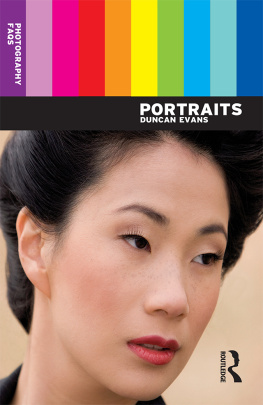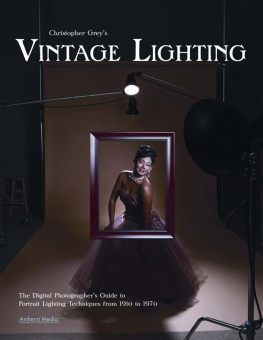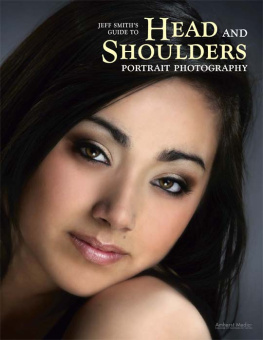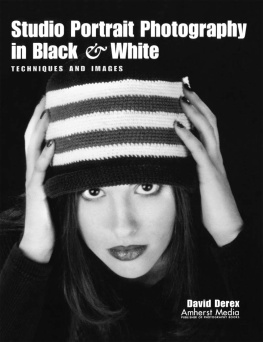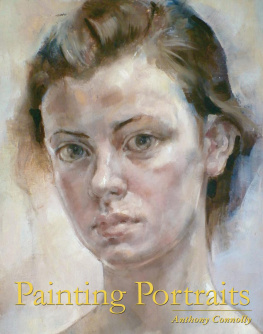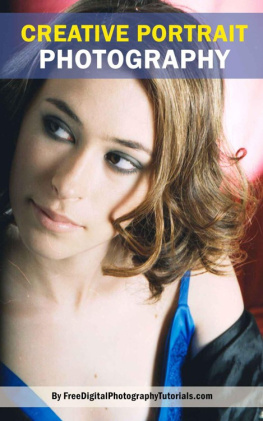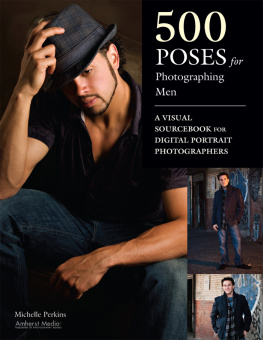
train your gaze
a practical and theoretical introduction to portrait photography
e
roswell angier
train your gaze
[A Practical and Theoretical Introduction to Portrait Photography]
An AVA Book
Published by AVA Publishing SA
Rue des Fontenailles 16
Case Postale
1000 Lausanne 6
Switzerland
Tel: +41 786 005 109
Distributed by Thames & Hudson (ex-North America)
181a High Holborn London WC1V 7QX United Kingdom Tel: +44 20 7845 5000 Fax: +44 20 7845 5055
Distributed in the USA & Canada by: Watson-Guptill Publications
770 Broadway
New York, New York 10003
USA
Fax: 1-646-654-5487
English Language Support Office
AVA Publishing (UK) Ltd.
Tel: +44 1903 204 455
Copyright AVA Publishing SA 2007
All rights reserved. No part of this publication may be reproduced, stored in a retrieval system or transmitted in any form or by any means, electronic, mechanical, photocopying, recording or otherwise, without permission of the copyright holder.
ISBN - 940373 - -X and - - 940373 - 37-6
Design
Christopher Cannon,
Eric Baker Design Associates
Cover Image
Stranger, 1999"
Shizuka Yokomizo. Courtesy of Cohan and Leslie, New York
Index courtesy of Indexing Specialists (UK) Ltd.
Production by
AVA Book Production Pte. Ltd., Singapore Tel: +65 6334 8173 Fax: +65 6259 9830
All reasonable attempts have been made to trace, clear and credit the copyright holders of the images reproduced in this book. However, if any credits have been inadvertently omitted, the publisher will endeavor to incorporate amendments in future editions.
train your gaze
[A Practical and Theoretical Introduction to Portrait Photography ]
roswell angier
dVd Academia
the environment of learning
contents
how to get the most out of this book
Each of the 12 chapters in this book consists of three elements: a critical and/or historical examination of one singular aspect of portrait photography, illustrative photographs from the past and present, and a related shooting assignment. The book can be treated as a read-through experience, with the chapters studied in numerical order, or it can be used as a reference guide, with the reader choosing the way.
This spread shows an example of a chapter opener. The navigation bar at the top of each chapter opener allows readers to gauge where they are within the book.

self - portrait/no face
A sample spread from the book showing an image and caption, main text and a pull quote. All captions state the title of an image, its date, the photographer or artist, and any other necessary information. Pull quotes appear throughout the book to emphasize key points.
"'Imagine an underground chamber like a cave, with a long entrance open to the daylight and as wide as the cave. In this chamber are men who have been prisoners there since they were children, their legs and necks being so fastened that they can only look straight ahead of them and cannot turn their heads. Some way off, behind and higher up, a fire is burning, and between the fire and the prisoners and above them runs a road, in front of which a curtain-wall has been built, like the screen at puppet shows between the operators and their audience, above which they show their puppets.
supplemental light. Youshould be aware ofthe fact that, in order tocorrectlyexpose your film, light levels deaesse, in-camera metering systems become Increasrnrly unreliable. W/hie some of
S3)
Where another publication is referenced within the main text, a source footnote provides necessary information that can help the reader who wants to do further research.
Each chapter contains a shooting assignment. The assignments provide a practical, structured context, within which the student can experiment with different approaches to a concrete portrait situation.
I want to take your
picture
introduction
this may be an utterly casual declaration . Or it may express your desire to extend the momentum of an initial glance, a spark of fascination that has already occurred. Or it may function as a hopeful mantra, intended to create the very conditions in which that spark might be ignited.
If you ask politely for permissionMay I take your picture? the chances are that you are speaking to a stranger. If, on the other hand, you say I would like to make a portrait of you, the circumstances are entirely different. First of all, you probably know this person.
Second, and perhaps more important, is the fact that the word portrait has a special meaning. Portentous, loaded with gravity and subtle persuasion, without really saying anything about what it is that you want, it nonetheless reassures your subject about the seriousness of your intentions. It may influence the behavior of your subject, opening the door to anxiety and trepidation (Should I look serious? Should I be wearing something special? are two possibilities). It can discourage playfulness and experimentation.
A portrait, the result of a consensual process, depends upon the subjects agreement to be photographed. It assumes a level of trust. The subject usually faces the camera, and the contract between subject and photographer hangs palpably in the air that separates them. It is across this agreed-upon distance that all sorts of power relationships and tensions between or among the people involved are negotiated. The picture itself records this exchange.
This book is about photographing human subjectsin many different ways and from a number of different perspectives.
It is addressed to people who are already acquainted with photography. A basic competence with cameras, darkrooms and/or image-processing software is assumed, although not required for an understanding of most of this book. The technical matters discussed here are limited to key elements of the image capture process, and can be found chiefly in the three appendices.
This is nonetheless a practical book. It addresses issues of content, paying attention to history, theory, and formal analysis along the way. A great deal of attention is paid to different aspects of the picture-making process, and to the conditions surrounding that process. There are shooting assignments to perform, different kinds of photographs to make. With that in mind as the final objective, there is ample discussion of images made by different photographers. Some of these images are portraits in a classic sense (they are likenesses, or pictures that explore ideas about personal identity in a predictable way), and some are not (such as certain street photographs and fictional tableaux).
What is common to all the images with which this book is concerned, of course, is the presence of a subjecta person or a group of people on the other side of the lens. But there is something else of equal importance, something that is not literally visible in the image. It is something quite apart from the manifest subject. It is what finally makes a picture come alive. It is the presence of the photographers thoughtful regard. This ingredient, if thats what it can be called, is not simply a way station in the picture-making procedure. It cannot be reduced to a burst of enthusiasm, a brilliant concept, a compositional strategy, or a stylistic quirk. This characteristic, this something that inhabits a picture, is the felt activity of someone looking, the photographer in person, embedded in the photograph.


